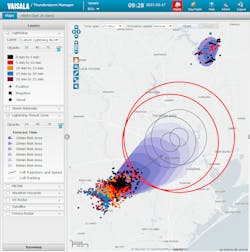How Lightning Detection Networks Increase the Safety and Efficiency of Airport Operations
Every year, the world sees about 16 million thunderstorms, and there are nearly 2,000 storms in progress at any given moment worldwide. Given the global frequency of such storms — and lightning being responsible for up to an estimated 24,000 deaths per year globally — it should not come as a surprise that lightning can have a significant impact on the aviation industry.
From aircraft damage, avionics interference and engine shutdown to pilot incapacitation, inefficient airport operations and staff safety-related risks, lightning can have a wide range of negative impacts on air travel. Although lightning activity can vary by geographic location, experts estimate that each airplane in the U.S. commercial fleet is struck by lightning every 1,000 hours of flight — or about once per aircraft per year. While the last confirmed commercial plane crash in the U.S. directly attributed to lightning occurred in the ’60s, the threat of lightning can still bring airport operations to a grinding halt — and put safety at risk.
Since lightning is a grave threat to airport ground operations personnel, lightning-related delays can have a costly impact locally as well as across the global National Airspace System. In fact, the estimated cost for each minute airport operations are delayed is roughly $12,000, and just a 10-minute improvement in addressing lightning delays at one of the most at-risk airports for lightning in the U.S. can result potential savings of $6.2 million annually.
That is why it is crucial that airport lightning-warning systems are able to precisely identify when lightning is in close proximity and ramp closures must be in effect to help airport decision-makers overcome any safety- and efficiency-related challenges. When it’s your job to maintain safety, efficiency and on-time departures, every minute counts because lightning can undeniably have an outsized impact on uptime, safety, sustainability and overall operations. In order to maintain scheduled operations and keep staff and travelers safe, decision-makers require precise and timely lightning information in order to plan ahead, quickly react to changing circumstances and ultimately reduce disruptive delays.
Lightning-Related Challenges Impacting Daily Operations and Personal Safety
Whether handling baggage, serving food, refueling, tugging and guiding aircraft to and from gates, or maintaining airport grounds, lightning strikes can cause serious injuries or death to airport personnel. In addition to the personal danger facing airport ground operations staff, travelers face lightning-related safety risks too. When there is no jet bridge available, passengers have to exit the plane out onto the open tarmac and make their way to the terminal, risking exposure as they make their way inside the airport. Complicating matters further, jet bridges are unsafe during lightning events, and most major airlines will not allow passengers to exit the plane through the jet bridge when there is lightning nearby.
Entirely too many airports struggle to effectively monitor for lightning. While some smaller airports only use audible thunder as an indicator of the presence of nearby lightning, most major airports utilize single-point sensors, which deliver information surrounding the direction of the storm and the storm’s distance to the airport, on their automatic weather stations. These sensors, however, do not communicate a storm’s exact location nor do they classify whether a stroke remains in the cloud or moves from the cloud to the ground.
Finally, uncertainty and lack of standardization are significant challenges when looking at safety and efficiency of operations. From inaccurate lightning information to disparate established organizational safety procedures and human factors, a wide range of uncertainties are involved in the ramp closure decision-making process.
Currently, there is no centralized guidance for an airport in the United States, which yields situations in which airport decision-makers utilize lightning information obtained from different sources, and there can be significant accuracy differences in determining the location, number and type of lightning detected. Warning criteria requires serious consideration, including time to notify ground staff, time to safely stop operations and time to get to safety.
Typically, ramps are closed in response to a first lightning strike within a critical distance of the airport and waiting a defined amount of time following the last strike until it is again deemed safe to resume outdoor operations. In “Balancing Safety and Efficiency of Airport Operations under Lightning Threats,” Dr. Matthias Steiner notes that the “primary source of uncertainty is related to the critical distance (from the terminal area where people work outdoors) and timing (i.e., waiting period after the last lightning strike) criteria.” For example, at the same airport, decision-maker 1 might close the ramp if lightning occurs within a critical distance of five miles and wait 15 minutes after the last lightning strike within that distance before resuming outdoor work. Decision-maker 2, on the other hand, might employ a critical distance of three miles and waiting period of just six minutes.
Without a comprehensive lightning detection network, balancing minimized operational downtime with maximized safety remains a difficult task.
How Real-Time Lightning Detection and Data Mitigates Risk and Improves Safety
With lightning season now in full force, having reliable storm and lightning information with unmatched efficiency and location accuracy is not only essential but possible with a comprehensive lightning detection network in place.
By providing comprehensive, reliable data, including detecting both in-cloud and cloud-to-ground lightning, lightning detection networks can be used to trigger lightning warnings that keep airport and airline staff and passengers safe while ensuring operations run at optimal efficiency.
Comprehensive lightning detection networks that leverage satellite and sensor technologies can estimate the development of approaching storms, as well as overhead accumulation and dispersion. Even though storms that develop directly above an airport are not common, they can also be significantly more dangerous and require instant warning of an immediate safety threat. A high-quality network of lightning sensors can detect lightning in the area around and directly above airports, providing operational decision-makers with adequate time to stop operations and get to a safe location.
Current state-of-the-art sensors use a combination of magnetic direction finding and time-of-arrival techniques to deliver superior detection efficiency, optimal location accuracy and system redundancy. As a result, such lightning detection networks deliver significantly greater accuracy, capturing more of the real-time lightning data required for effective early alerts, lightning reports, and accurate risk modeling, policy planning and incident investigations. With this accurate and trusted information, airport decision-makers will know each type of lightning, its intensity and frequency, storm speed and direction, and when the storm is clear of their location.
Trusted by airports around the globe, Vaisala’s National Lightning Detection Network and Global Lightning Dataset GLD360 network excel at detection efficiency. GLD360 detects over two billion lightning events per year, while more than 95% of all cloud-to-ground flashes are detected by NLDN, as are more than 70% of the cloud-to-ground strokes that make up the flashes. As a result, networks like GLD360 and NLDN can help eliminate costly false alarms and lower the impact of unnecessary delays.
Formulating an effective organizational safety procedure is next to impossible when reliable and timely thunderstorm information is not readily available. The more precise a lightning data set is, the more accurate airport stakeholders can be in making safety- and efficiency-centric decisions. Without reliable lightning information, decision-makers could begin closing ramps too early, close them for too long or miss storms entirely. Employing a global sensor network provides airport authorities with the information they need to increase safety, maximize the efficiency of operations and minimize downtime.
Ronald Holle is a senior scientist and has worked extensively in meteorological education issues, particularly those relating to lightning safety and the demographics of lightning victims. Prior to joining Vaisala, he worked with the NOAA Research Laboratories for 38 years. He is a Fellow of the American Meteorological Society, and a member of the Executive Committee of the African Centres for Lightning & Electromagnetics Network, a pan-African network of centers dedicated to decreasing deaths, injuries and property damage from lightning.




